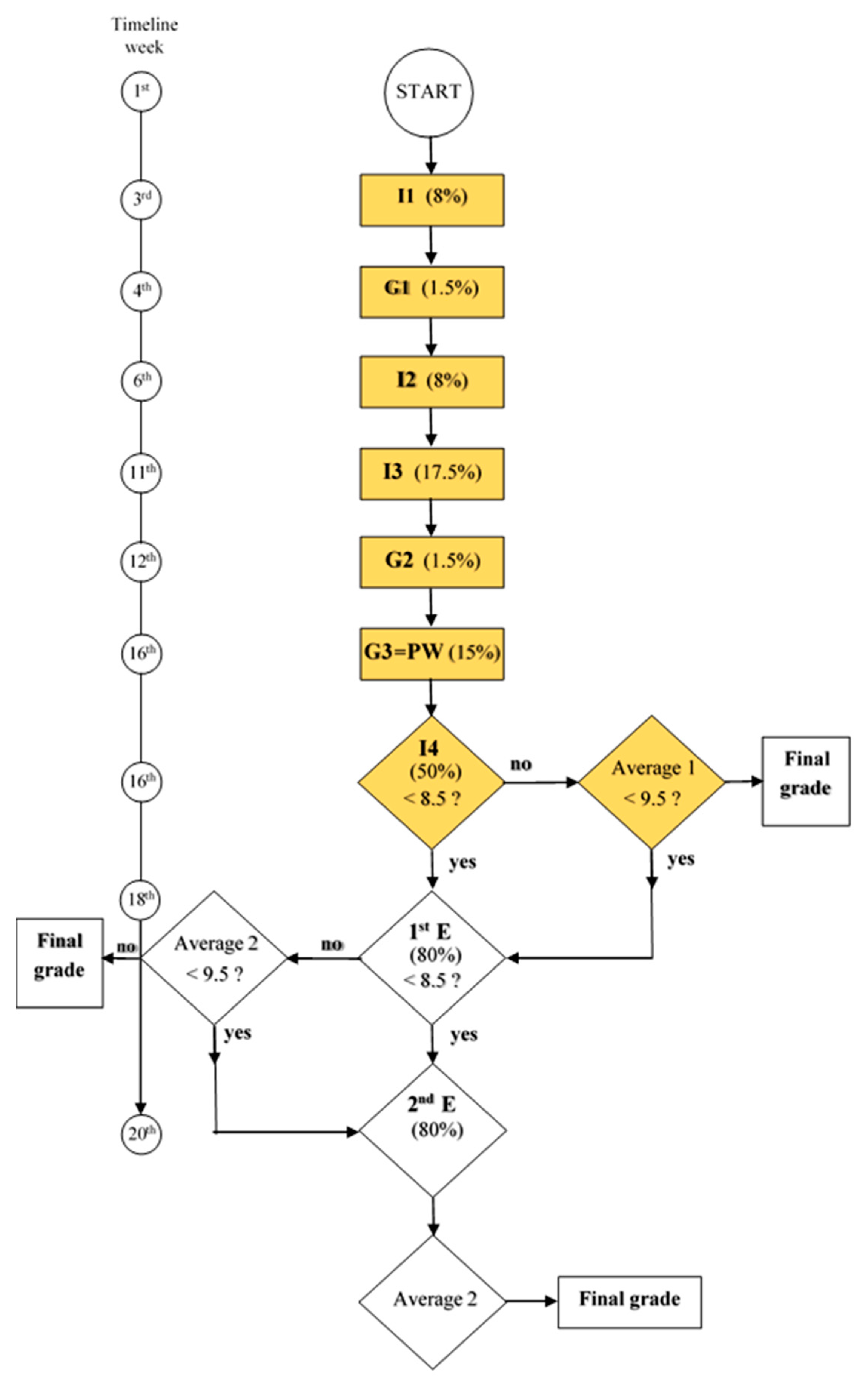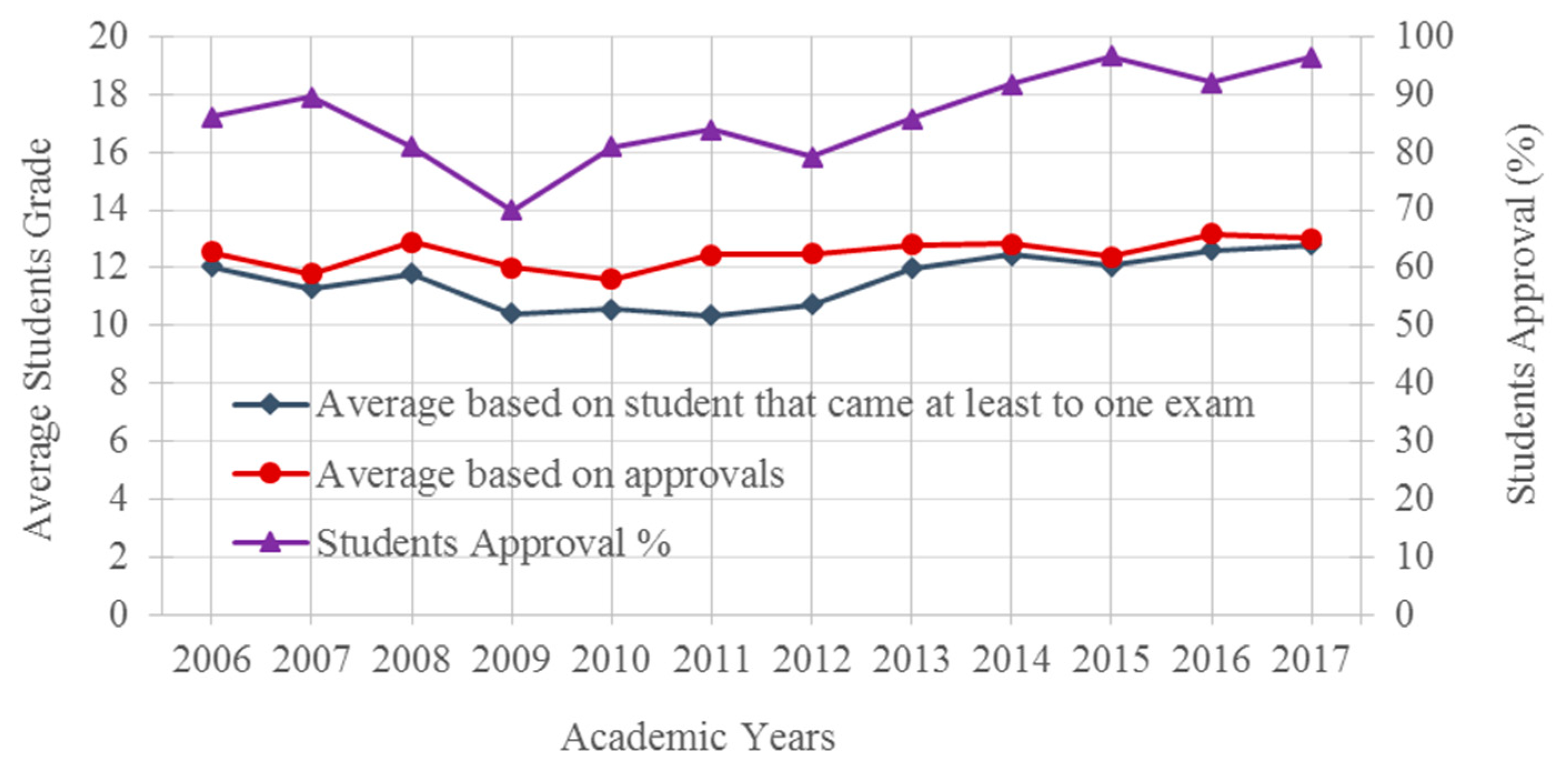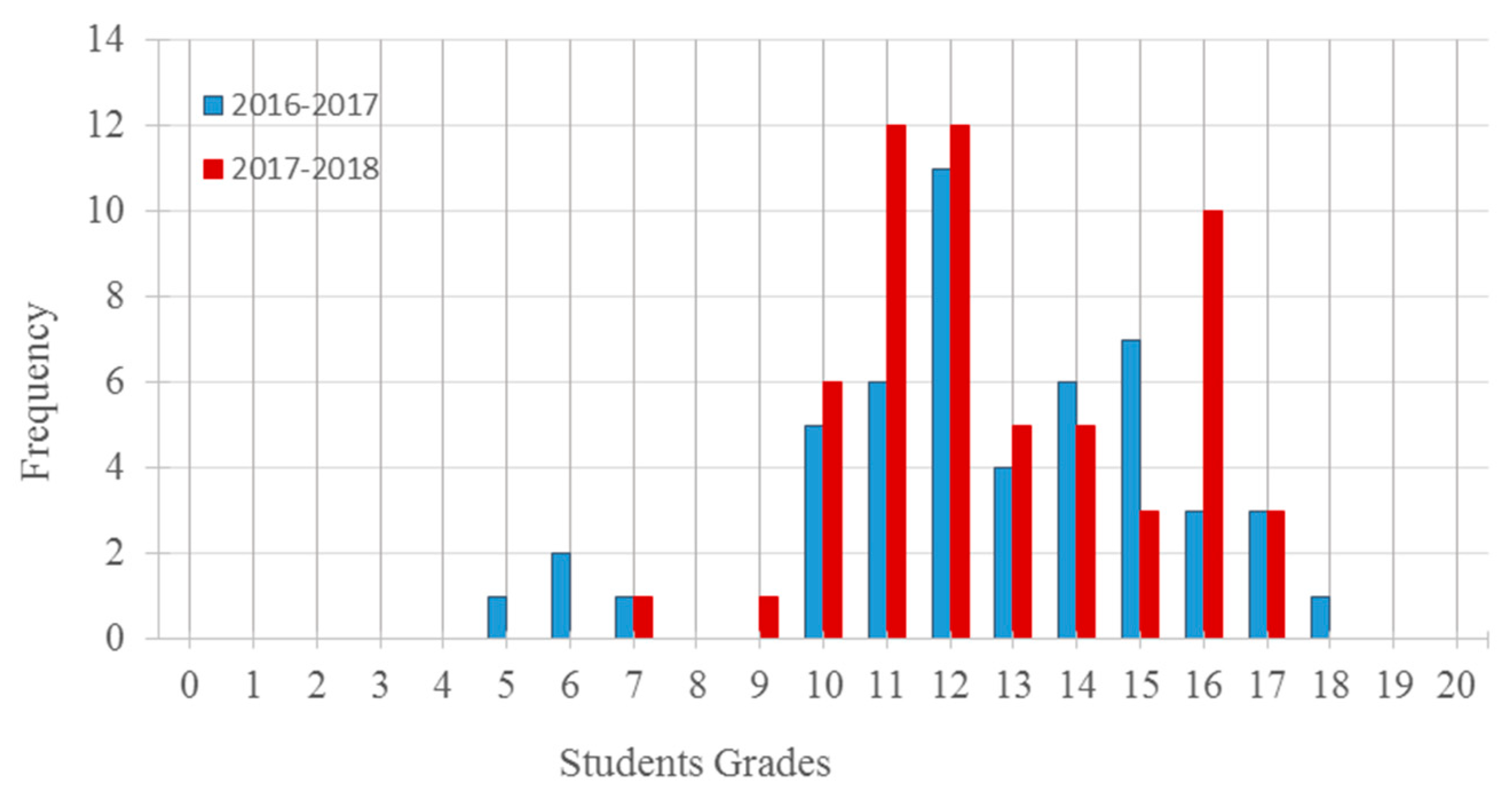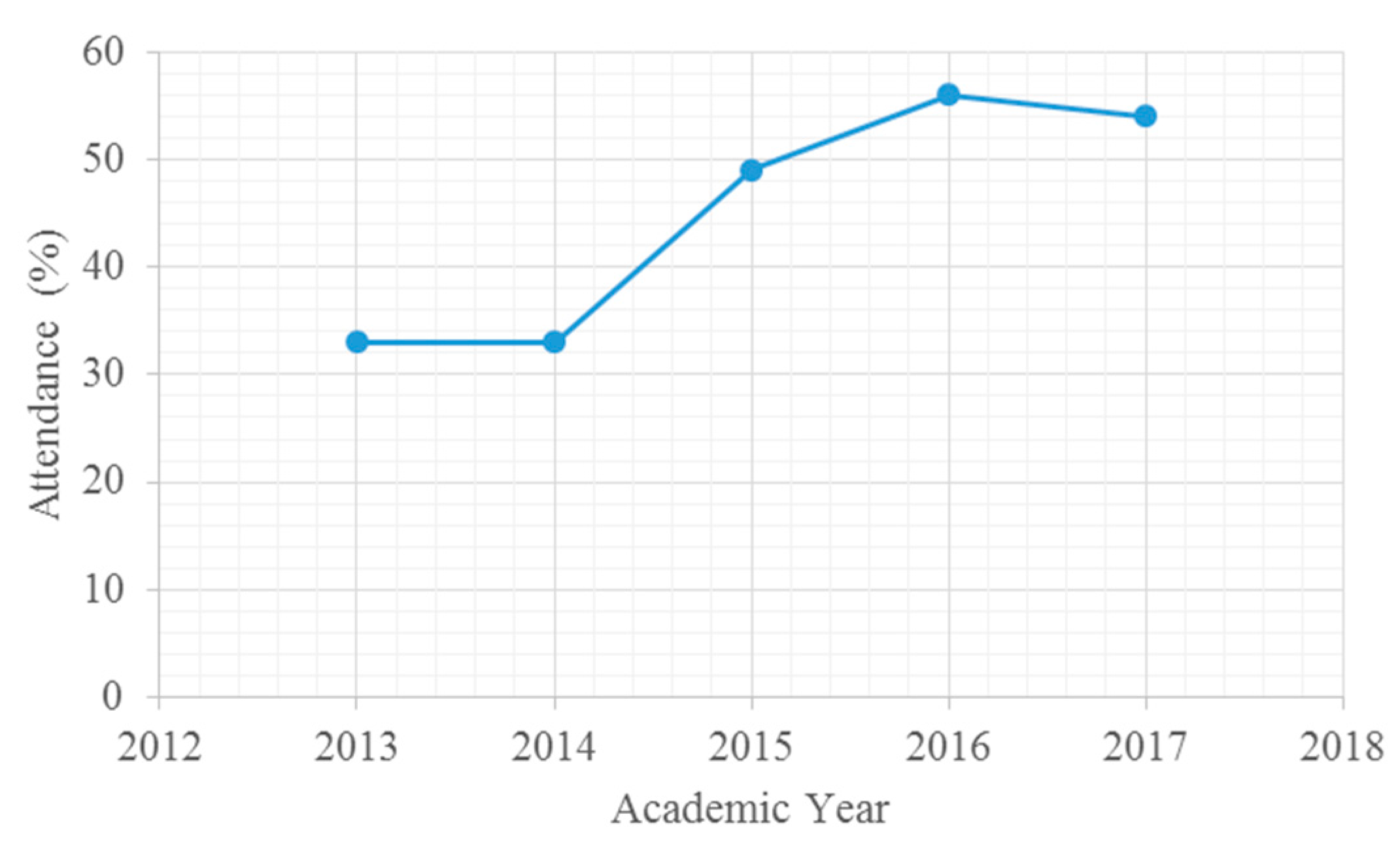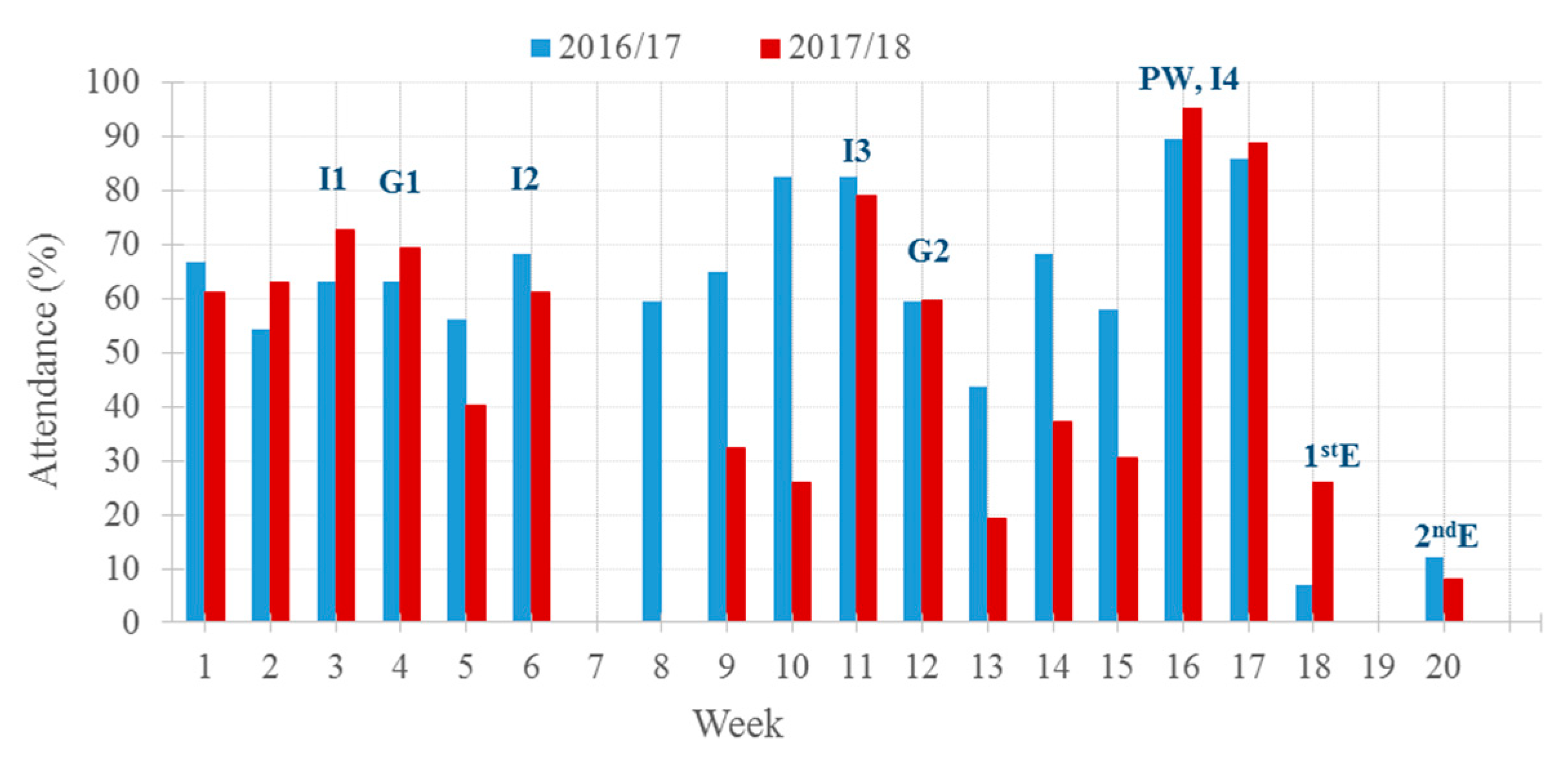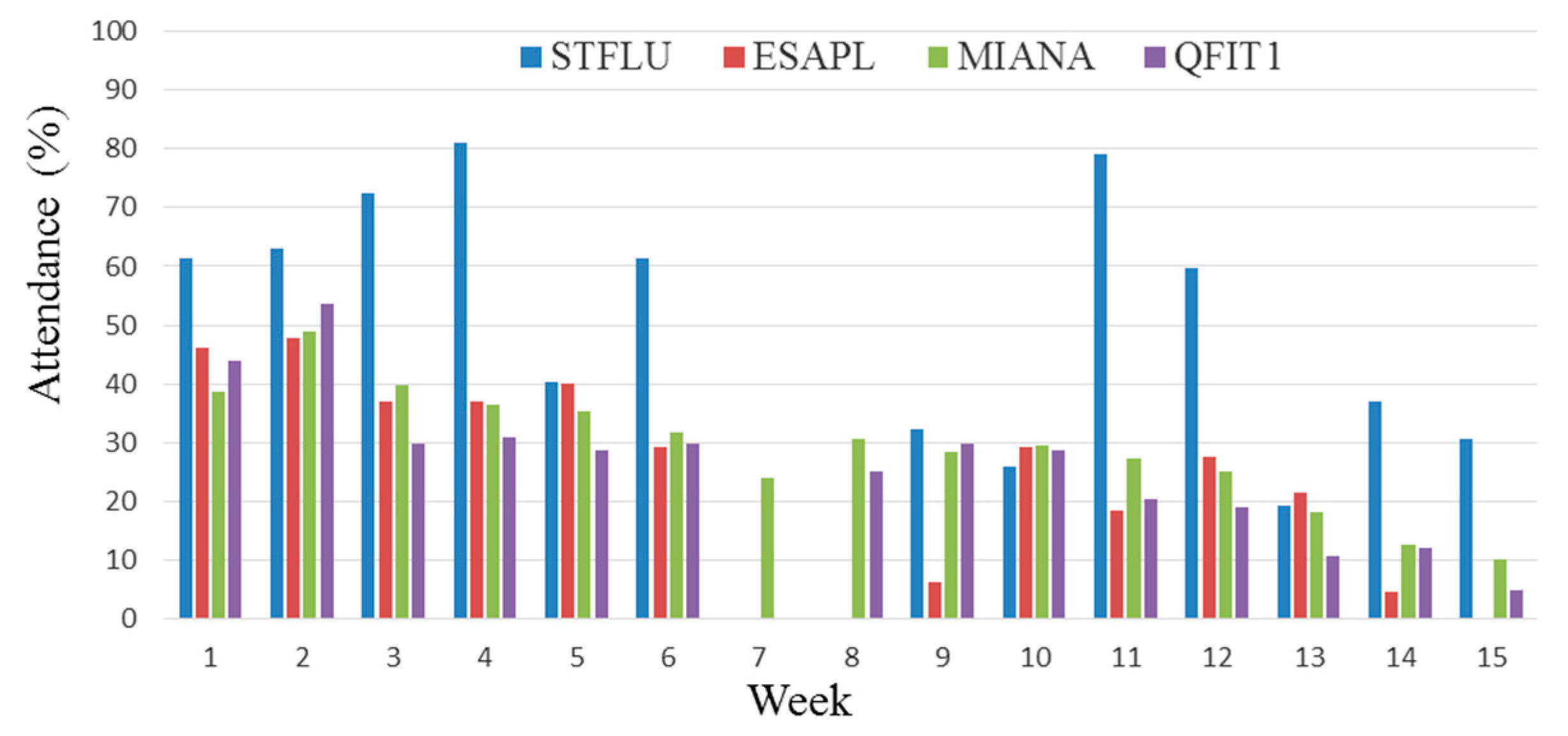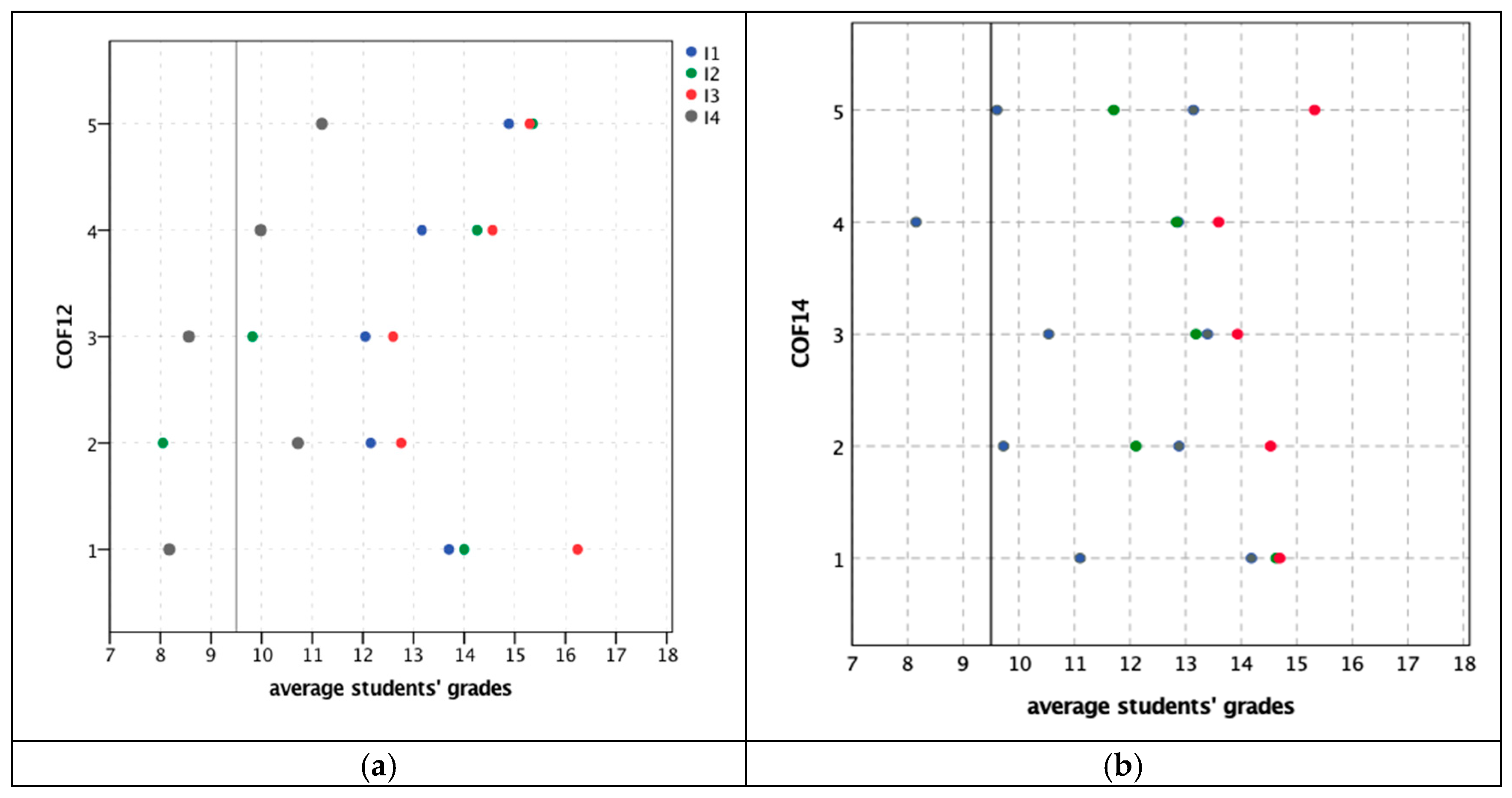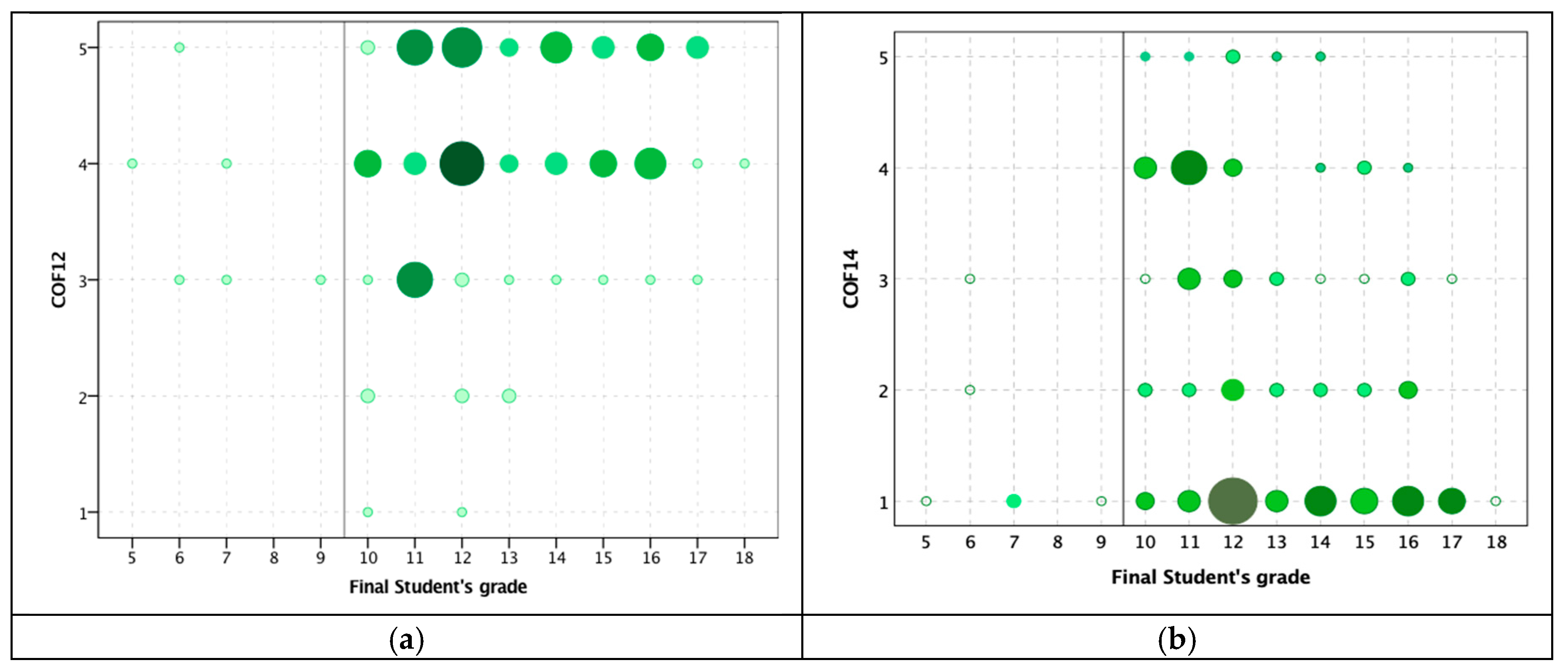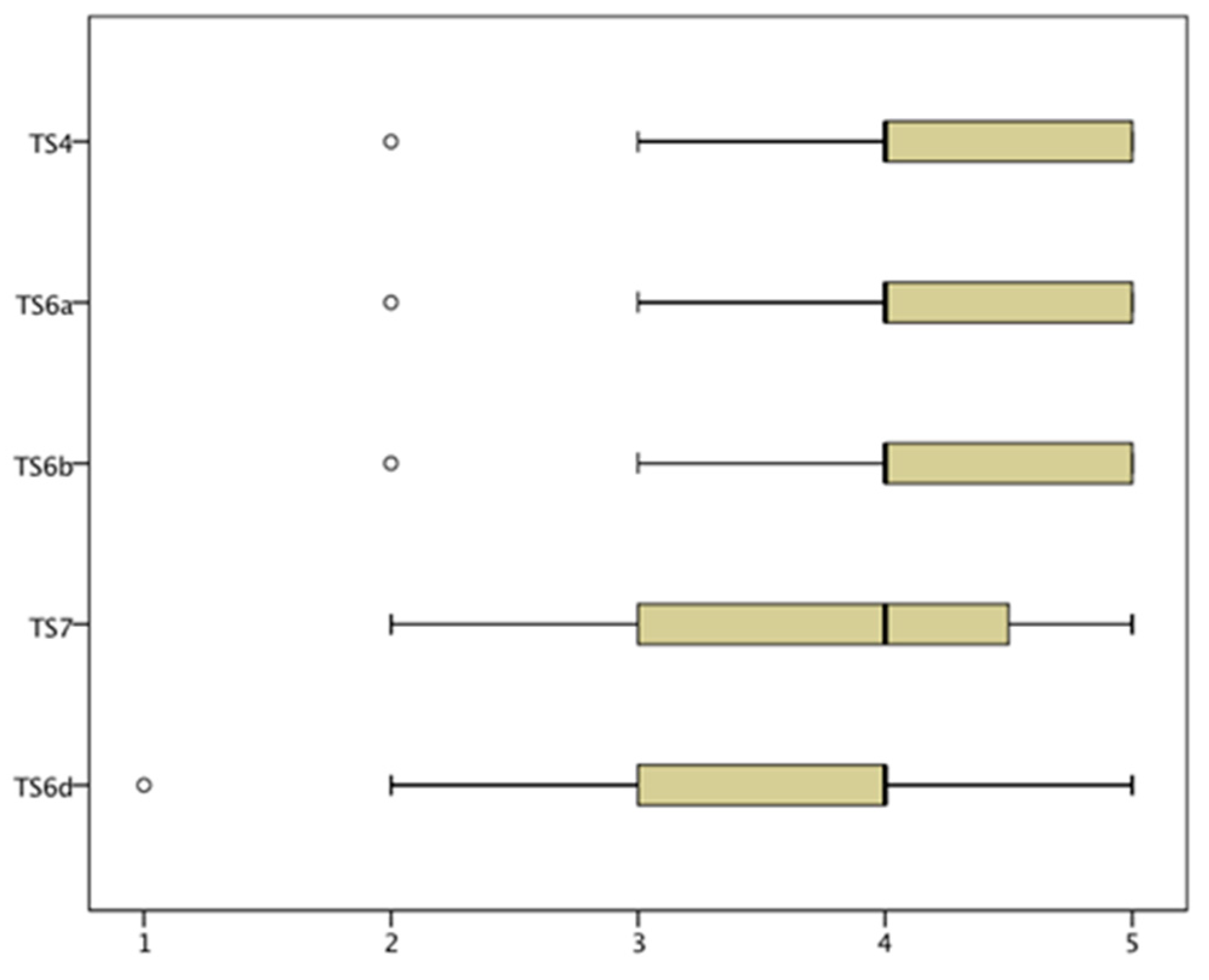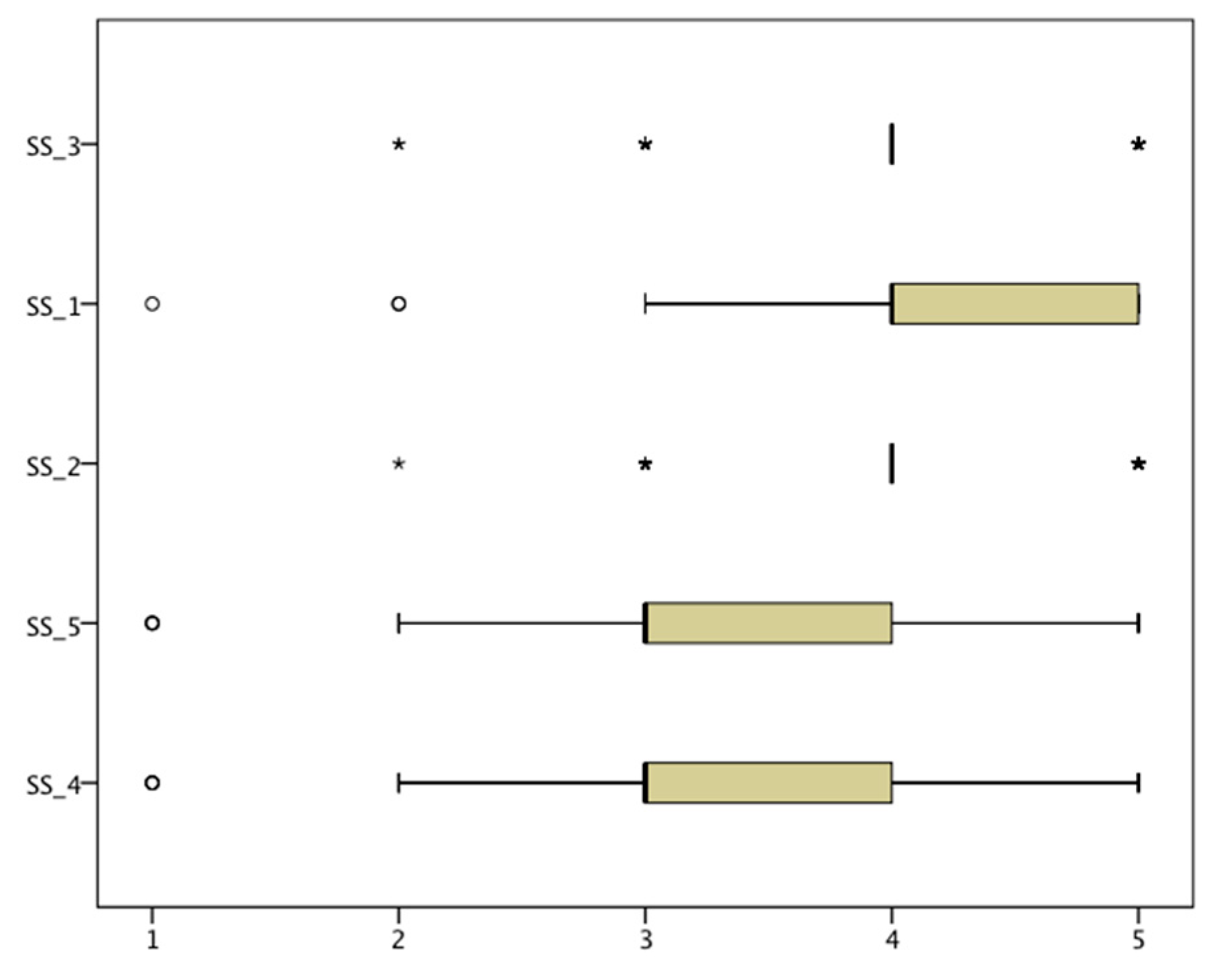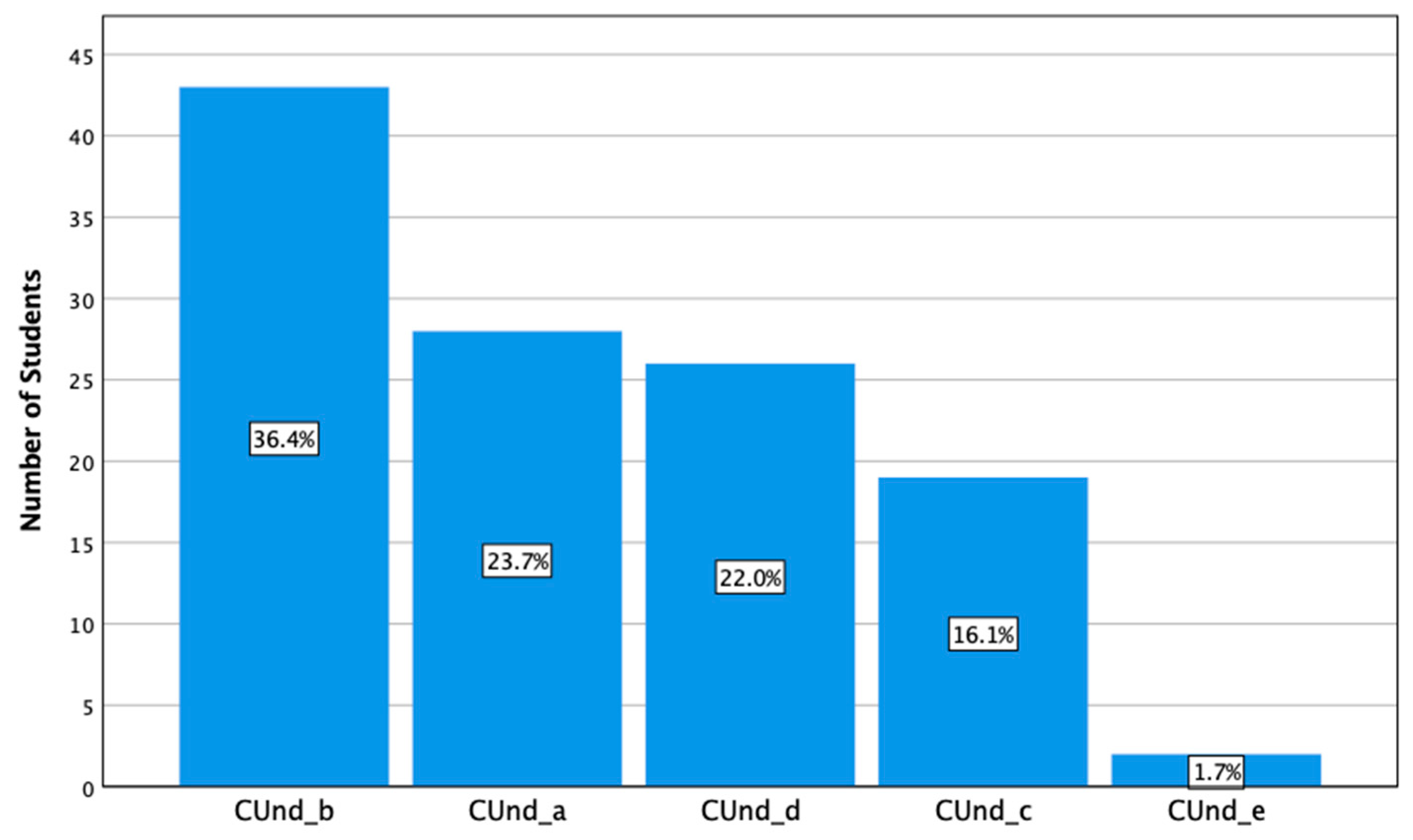3.1. Grades and Attendance
The average final grade for those students who appeared at least at one exam moment, the average final grade and the percentage of students who were approved in the STFLU course, are shown in
Figure 2 for the different academic years (from 2006/07 to 2017/18).
According to
Figure 2, the lowest approval percentage of students (about 70%) occurred in the academic year 2009/10, the exact year in which PW was not done. The average student grade based on approvals did not change greatly during that period and was around 12 out of 20. It would be premature, based on this amount of data, to correlate this value with the absence of PW in 2009/10. However, for the two last academic years (2016/17 and 2017/18), it is evident that there is a similarity of the average grade based on approvals when compared with the average grade based on students that came at least to one exam. Therefore, almost all students who presented themselves to an evaluation had a positive grade. This can also be reinforced by the analysis of
Figure 3.
Figure 3 shows the final grade distribution (number of students that obtained each of the possible grades between 0 and 20) for the academic years 2016/17 and 2017/18. There were few failing grades in these two academic years (grades lower than or equal to 9), corresponding to 3.4%.
Figure 4 shows the average attendance (to theoretical classes) during the academic years between 2013/14 and 2017/18. The attendance data before 2013/14 were not available.
As attendance at theoretical-practical classes (TP) is mandatory, and the student can only miss 1/3 of the classes (about 5 in 15 classes), attendance is high. According to
Figure 4, the level of attendance at theoretical classes was only higher than fifty percent in the last two academic years, which coincides with the period in which more changes were made to the assessment methodology. In that period, six more points of assessment were introduced.
Figure 5 shows the attendance for each theoretical class during the academic years 2016/17 and 2017/18 in more detail.
It is evident that the highest attendance at theoretical classes corresponds to the evaluation days (see the moments identified in
Figure 5). Strangely, students missed classes during the week before the assessment moment (see moment I2). However, as stated by Gurung [
22], some students tend to do what they should not do, namely, skip classes. Moreover, this behaviour appears not to have had a negative effect on the students’ performance, since the majority of them passed the attendance requirement. In addition, this can be confirmed by the low attendance at moments 1st E (normal exam) and 2nd E (supplementary exam).
Comparing year 2016/17 to 2017/18, a higher attendance in the 1st E (1st Exam) in the year 2017/18 can be seen, because a minimum frequency of attendance was instituted. The low attendance at theoretical classes that have no moments of evaluation in 2017/18 when compared to 2016/17 seems to be a characteristic of the year. When comparing the attendance of all courses of the 2nd year/1st semester (
Figure 6), it is obvious that low attendance was a common factor among all of them. This difference observed between 2016/17 and 2017/18 seemed not to influence either the average attendance (
Figure 4) or the students’ mean final grade (
Figure 2). Based on these numbers, and as confirmed in the study by Alhija [
23], students perceived assessment as the most important of the five teaching dimensions (goals to be achieved, relations with students, teaching methods and characteristics, assessment, long-term student development); therefore, they tended not to miss these moments. The teaching methods were of as little importance as the goals to be achieved and the relations with students.
So the assessment methodology changed the students’ attendance at theoretical classes significantly. In general, the majority of the students only attended theoretical classes when they were forced to do it!
This, in a certain way, is in line with the thoughts of Gurung [
22] with respect to the idea that teachers can modify the method to assess different levels of classes, and that they should help students to prepare more effectively for exams or other types of assessment. In addition, they can also inform students about study techniques that may be more beneficial to them, since the most important thing is how students study.
3.2. Student Perceptions
The results analysis of the students’ perceptions regarding the STFLU course are presented and discussed below. The SPSS statistical tool was used for data analysis [
21].
As the data collected from the students do not follow normality (normality was checked with the Shapiro-Wilk test for normality of the data), non-parametric tests were considered in the analysis and to be able to provide answers to the research questions raised (Mann-Whitney (U), for the comparison of two independent samples means as an alternative to the independent sample t-test, and the Spearman’s correlation coefficient (rS) to study and measure the strength of the relationship between two ranked variables/items). A significance level of 5% was considered, meaning that differences were considered to be statistically significant for p < 0.05. Both tables and figures are used, when pertinent, to summarise information and to illustrate specific trends or features.
The following research questions will be answered in the subsequent sections:
RQ—How do students perceive the assessment methodology?
sRQ1—How important is the PW in the students’ learning process?
sRQ2—Is the PW perceived as an autonomous tool?
sRQ3—Is the PW effective at preparing students for the challenges of professional life?
sRQ4—Which competences did students acquire with the PW?
sRQ5—Are the students confident with the knowledge acquired with the PW to size a proper fluid transport system?
3.2.1. How Do Students Perceive the Assessment Methodology? (RQ)
To answer RQ, from the 15 items evaluated in part 6 of the questionnaire (course organisation and functioning, COF), 14 will be analysed (COF1 to COF14). Furthermore, the individual (Ii) and final students’ grades will be related with some of these items allowing to understand possible relations between both. The 14 items under analysis are:
COF1: The examples used by the teachers help the understanding of the contents.
COF2: The teachers try to contextualise the contents in a professional perspective.
COF3: I am interested in learning the contents of the CU.
COF4: I participate in discussions in the classroom.
COF5: The quantity of contents covered in the CU is adequate.
COF6: The practical works/exercises indicated are appropriate to the contents covered in the CU.
COF7: In general, the CU meets my expectations.
COF8: The CU is essentially theoretical.
COF9: Theory is important to understand the practical applications.
COF10: The practical applications proposed are sufficient to understand the concepts.
COF11: The practical applications proposed are sufficient to understand the real applicability of the concepts.
COF12: The evaluation through questions/problems and small tests during theoretical lessons was beneficial to my learning.
COF13: For the intermediate assessment, I prefer several questions/problems and small tests during theoretical classes.
COF14: For the intermediate assessment, I prefer to carry out a single moment of evaluation/test.
Despite a general downward trend, on average, from the 2016/17 academic year to 2017/18, the students’ evaluations in these COF items show similar behaviour (
Table 2), i.e., there was no statistically significant change in the students’ evaluation between the two academic years (for all the items under analyses
p > 0.05). Since no significant differences were obtained, from here on, the results and analysis will be discussed as a whole.
The lowest result obtained was for items COF14 (For the intermediate assessment, I prefer to carry out a single moment of evaluation and test) and COF8 (The CU is essentially theoretical), with average values lower than 3, showing a disagreement in opinion regarding these two items. However, this behaviour in itself suggests a positive perception regarding the change in the assessment of the theoretical topics such as Fluid Mechanics, making them more practical.
Conversely, the COF items with the highest mean (values higher than 4, showing an agreement in opinion) was COF1 (The examples used by the teachers help the understanding of the contents), COF6 (The practical work/exercises indicated are appropriate to the contents covered in the CU), COF2 (The teachers try to contextualise the contents in a professional perspective), COF3 (I am interested in learning the contents of the CU), COF7 (In general, the CU meets my expectations), COF5 (The quantity of contents covered in the CU is adequate) and COF12 (The evaluation through questions/problems and small tests during theoretical lesson was beneficial to my learning). COF13 (For the intermediate assessment, I prefer several questions/problems and small tests during theoretical classes) presents similar results to COF12, although slightly lower. This could indicate that there is a difference between what students prefer and what is beneficial in terms of learning for them. These results are to some degree in line with the results obtained by Struyven and co-authors in their review work [
24], in that what students perceive regarding assessment seems to have a considerable impact on students’ learning approaches, and vice versa.
To understand if there is a relationship between the individual (Ii) and students’ final grades with respect to the perception that students have regarding assessment methodology, some of the COF items (COF12 and COF14) will be used.
Figure 7 shows the average of the students’ grades obtained in the four individual assessment moments against the students’ perceptions regarding items COF12 and COF14. The individual assessment is the core of the evaluation, and accounts for 83.5% of the final grade (
Figure 1).
As can be seen, there is no defined pattern between the grades in different moments and agreement level with the COF12 item statement. For example, students that are strongly in disagreement (1) with “The evaluation through questions/problems and small tests during theoretical lessons was beneficial to my learning” obtained the highest and the lowest grades (on average). However, all the students that are in complete agreement (5) obtained a positive grade (average ranged from 11 to around 15). Regarding COF14, “For the intermediate assessment, I prefer to carry out a single moment of evaluation and test”, the behaviour obtained was more dispersed, making the interpretation more difficult (
Figure 7b). That is, for the same individual grade (Ii), students show different evaluations.
By considering the students’ final grades, the distribution according to the corresponding students’ items evaluation undergoes some changes (
Figure 8). Each mark size and colour intensity shown in
Figure 8 reflects the number of students in each grid cell (the darkest and largest mark corresponds to 9 students, and then decreases successively until 1). Notice that the levels of agreement for COF12 (
Figure 8a) for the 5.6% students that failed (final grade ≤ 9.5) were somewhat positive (3—neither agree nor disagree, 4—agree, 5—strongly agree). It is important, however, to emphasise that 72.6% of students with final grades ≥ 9.5 agree and strongly agree that the evaluation adopted was beneficial to their learning.
Figure 8b shows an opposite evaluation behaviour when looking to the opinions regarding intermediate assessment, where the majority of students (1—strongly disagree, 2—disagree) do not prefer to carry out a single moment of evaluation and test (COF14) independently of the final grade.
3.2.2. How Important is PW in the Students’ Learning Process? (sRQ1)
As a measure of how important students perceived the PW to be in their learning process, a set of technical skills acquired with the PW (part 3 of the questionnaire, TS items) was considered:
TS4: PW is a useful tool in supporting the CU,
TS6a: Overall, the PW helped me to assimilate the concepts transmitted throughout the semester,
TS6b: Overall, the PW has made my learning more objective,
TS6d: Overall, the PW motivated me to the CU,
TS7: Overall, I felt motivated to carry out the PW,
TS9: The PW motivated me to learn the CU contents,
TS10: Would you recommend doing a PW as a teaching/learning activity?
The two last items (TS9 and TS10) are “No/Yes” questions.
Table 3 and
Figure 9 summarise and illustrate the distribution of the obtained data, respectively.
Largely, students agreed (
Figure 9, more than 50% of agreement, 4 and 5) that the PW is an important and useful tool in supporting the CU (TS4). This item is the one with the highest evaluation (
Table 3, mean = 4.34). Even the item with the lowest evaluation (TS6d, mean = 3.80) reflects an agreement. In fact, this is the only item where the evaluation of 1 (strong disagreement) was obtained. The percentage of disagreement (1 and 2) corresponds to 3.7%, meaning that these students do not consider that the PW development has a motivating effect on the CU.
Despite the previous results, a majority of students (90.7%) consider that the PW motivated them to learn the CU contents (TS9), recommending (96.3%) the PW as a teaching activity in their learning process (TS10).
Knight, in their work [
25], stated that, related to group work development, students give more importance to students’ overall ‘group experience’ than the related learning outcomes/skills developed in group work. This could explain why some students did not consider the PW to be motivating for the CU.
3.2.3. Is the PW Perceived as an Autonomous Tool? (sRQ2)
To understand how students perceived the PW as an autonomous tool, item TS12, with a “No/Yes” answer (Do you consider that the PW should be less supervised by the teacher?), belonging to part 3 of the questionnaire (Technical Skills acquired with the PW), will be analysed. Since the students were asked to justify their answers to this question with words, this will also be analysed.
The majority of the students (94.4%) answered “No”. The justifications were related to the support that the teacher must give to students. For example: “it is necessary to have indications from the teacher for the development of the PW”; “teacher’ support is essential”; “in case of less support, we (students) would not manage to develop the PW”. These last comments are in opposition to the comments given by the minority of students that answered “Yes” (5.6%): “the PW obliges students to look for information”.
As previously mentioned (
Section 3.1), students’ attendance at theoretical classes was relatively low (high attendance only occurred at evaluation moments, as expected). It is in these classes that important and necessary PW information is given, so if students were present in these classes, the need for indications by the teacher could be diminished. Then, the teacher’s support would only be necessary for some doubts. As emphasised by one student, “even though the contents are taught, there are always some aspects that are specific and vary”.
Answers like “if the PW was less supervised the students would fill lost and would neglect it” shows that some students were not able to perceive the PW as a tool for applying their knowledge and understanding in solving new and practical problems.
It seems that, independently of approaches to learning and to teaching, student motivation is mainly associated with intrinsic or autonomous motivation and each student’s learning profile; moreover, student-centred learning environments do not guarantee success at motivating students to learn [
26].
3.2.4. Is the PW Effective for Preparing Students for the Challenges of Professional Life? (sRQ3)
To understand how students perceived the PW and their level of agreement regarding PW effectiveness as an autonomous tool, item TS11 (Do you consider that the PW should be carried out before the contents have been taught?) was related to the five items that measure the activity effectiveness (AE):
AE1—theoretical class where the teacher lectures the contents and a theoretical-practical class where applied exercises are solved,
AE2—previous study of theoretical concepts proposed by the teacher and discussion in theoretical class of the application of these concepts,
AE3—students individually solve a global question in the theoretical class using the knowledge they have,
AE4—theoretical class where the teacher presents the contents using practical examples and a theoretical-practical class where applied exercises are solved,
AE5—students solve a problem in groups in the theoretical class using the knowledge they have.
Table 4 presents the corresponding statistics in terms of minimum, maximum, mean and median values and the standard deviation.
On average, students considered the traditional teaching/learning methodology to be the most effective, that is, a theoretical class where the teacher presents the contents using practical examples and a theoretical-practical class in which applied exercises are solved (AE4, with 4.30 on a scale of 5), and where in the theoretical class, the teacher presents the contents and a theoretical-practical class in which applied exercises are solved (AE1, with 4.10 in a scale of 5).
Students considered the methodology in which students are required to undertake previous study of theoretical concepts proposed by the teacher, followed by a discussion in the theoretical class on the application of these concepts, to be of lower effectiveness (AE2, with 3.69 in a scale of 5).
To understand students’ choices regarding the effectiveness of the PW as an autonomous tool, these 5 items were correlated with item TS11.
Table 5 summarises the values of the Spearman coefficients obtained. None of the 5 items (AE1, AE2, AE3, AE4 and AE5) show a significant correlation with item TS11. To some extent, these results confirm earlier findings. However, slightly increasing the significance level to 6%, two positive correlations could be observed. That is, students who agree that the PW should be carried out before the contents have been taught also agree that they could first study the theoretical concepts proposed by the teacher and then discuss them later in theoretical class (AE2), and also agree that students could solve a problem in groups using the knowledge they have (AE5), understanding and identifying their difficulties.
3.2.5. Which Competences Did Students Acquire with the PW? (sRQ4)
To answer sRQ4, the five items in the soft skills part of the questionnaire (part 5) will be analysed concerning what the PW allowed:
SS1: to encourage collaborative work,
SS2: to stimulate my intellectual curiosity,
SS3: to provide necessary knowledge for my area of study,
SS4: to relate this CU to other CUs,
SS5: to apply the acquired concepts during the PW development in different CUs.
As for the previous items, for this set also, no statistical differences were obtained between the two academic years with regard to the way students evaluate them (
Table 6).
Figure 10 shows the distribution of the students’ evaluation for the five SS items considered in the questionnaire. The items evaluated more positively corresponded to SS3 (Provide necessary knowledge for my area of study), SS1 (Encourage collaborative work) and SS2 (Stimulate my intellectual curiosity).
The students were able to identify that the development of the PW helped in providing knowledge of the area under study (SS3). Only two students stated disagreement. Regarding SS4 and SS5, the majority of students still experienced difficulties in relating the acquired concepts to other subjects (55.1% and 51.4%, respectively, for disagree and do not know). This is not surprising, since the courses until the first semester of the second year are mainly basics courses (mathematics, physics and chemistry). Although they have an integrating laboratory (LABO3) in which they practice Fluid Mechanics simultaneously with STFLU, they do not relate STFLU to this other CU.
These results, together with the results obtained in
Section 3.2.1 (COF12), reinforce the idea that the PW and several moments of assessment can be used as tools promoting the acquisition of knowledge in Fluid Mechanics.
3.2.6. Are the Students Confident with the Knowledge Acquired with the PW in Sizing a Proper Fluid Transport System? (sRQ5)
To understand how confident students are with the knowledge acquired with the PW to size a proper fluid transport system, group 4, Concepts’ Understanding (CUnd) with PW development, was analysed. To this end, five sentences were given, and the student selected the most appropriate situation:
CUnd_a: with the PW development, now I am able to select a pump and size the involved system (pump and system characteristics, costs…) for any situation,
CUnd_b: with the PW development, now I am able to select a pump and size the involved system (pump and system characteristics, costs…) for a house/building,
CUnd_c: with the PW development, now I am able to select a pump (pump characteristics, costs …) for any situation,
CUnd_d: with the PW development, now I am able to select a pump (pump characteristics, costs…) for a house/building,
CUnd_e: with the PW development, I am still not able to select a pump and size the involved system (pump and system characteristics, costs…) for a house/building.
Figure 11 shows the percentage of students’ answers for each of the CUnd items.
As can be seen, the majority of students (60.1 %) were confident when selecting a pump and sizing the involved system (pump and system characteristics, costs …). Some students (38.1 %) were only confident when selecting a pump (pump characteristics, costs …) without sizing the complete flow system. Only 1.7 % of students (corresponding to 2 students) did not feel confident when sizing this type of system. These results reflect the problem associated with group work; that is, some groups split the tasks among them and only become aware of the contents that they developed, forgetting to integrate all of the contents [
27].
Nevertheless, these results show that students are in general confident with the knowledge acquired through PW.
